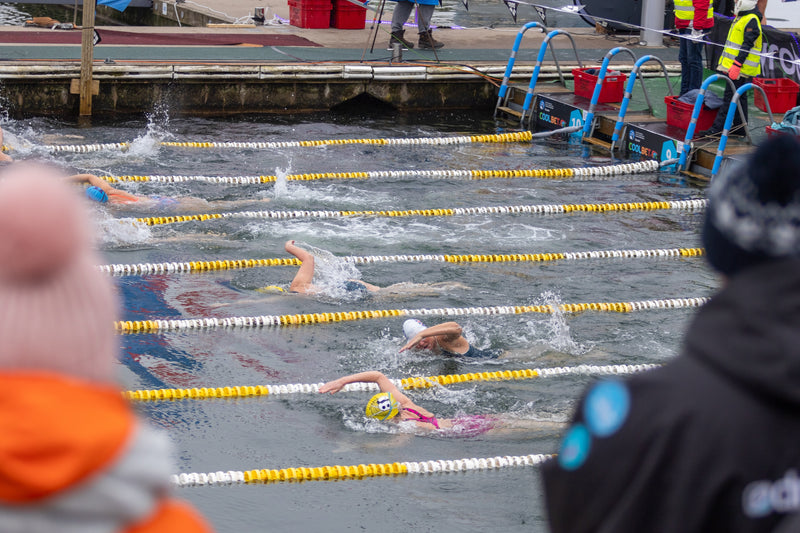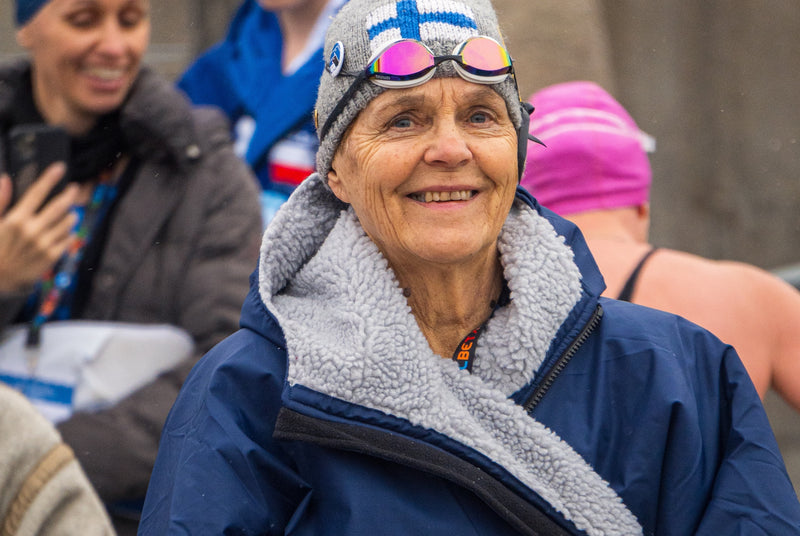9 minute(s) de lecture
The enchanting city of Tallinn hosted the biggest Winter Swimming World Championship (WSWC) to date in March 2024.
Over 5 days of competition from Tuesday 5th to Saturday 9th March, more than 1300 swimmers from 40 countries united in Estonia’s charming capital to conquer the cold of the Baltic Sea.
The event was an inclusive, global event for swimmers to safely endure the cold and celebrate resilience, human spirit, and adventure together.

What is the WSWC
The WSWC is a biennial event where committed swimmers can register and compete in a variety of race distances and strokes and embrace their dedication to winter swimming in incredibly cold temperatures. And, not forgetting one key rule, there are no wetsuits allowed!

The WSWC races are categorised by gender and age, ranging in distances from 25m to 450m in Breaststroke, Head-up breaststroke, Butterfly, and Freestyle. Swimmers could also compete in two international relay races as part of a team. Depending on the race distance, age categories range from participants below 14 years old to those over 90 years old.
The sheer number of heats demonstrated how popular the championships have become with swimmers from all over the world wanting to take part.

We were excited to catch up with dryrobe® Ambassador and ice and marathon swimmer Bárbara Hernández Huerta at the event who travelled from Chile, as part of the Chilean team for the first time since she competed in the event almost a decade ago. She explained why this event with the winter swimming community is so special:
‘The event is amazing. The first time we were here, it was just a little competition from Estonia and Finland and now we have 40 different countries taking part. A lot of Latin people too. Competing in these conditions is very hard. We see every age group in different races, and distances.
Even the youngest I think is 10 years old and the oldest is almost 90 - it’s amazing, I don’t know what other sport you can have that.’

Winter swimming conditions
Taking place in the Admiralty Basin in Tallinn Harbour, the water was Baltic in name and nature, reaching below 1°C at times throughout the week. The ice of the frozen 25-metre outdoor pool needed to be broken each morning, signalling the start of an exciting new day of winter swimming races.

For this kind of competition, Bárbara explained how she has been training in the run-up to the WSWC:
‘With my team, we’ve been training in Patagonia, in the glaciers, but also in normal conditions in a normal, warm swimming pool. We’re training in Santiago, the capital of Chile, in a very hot summer.
But for me, the most important thing is the mind, your purpose, and enjoying the competition. My body loves the cold. I think it’s for that reason that’s why I am called the Ice Mermaid maybe.’

When asked if it ever gets easier to swim in such cold temperatures, she explains:
‘It’s never easier, never. Even when I have the Guinness World Record for the longest distance in Antarctica. Every distance, every championship in the ice has lots of adrenaline. But also you’re a little bit scared. But so happy to be here. It’s a lot of emotions and feelings.
For me, I feel a bit nervous, then I’m happy, then I don’t want to go to the water. And then I’m just fine. I love it.’

As the event's headline sponsor, we were proud to provide free hire dryrobe® Advance changing robes for the swimmers taking part in extremely cold conditions. We’d love to take this opportunity to thank everyone who came to our hire stand to say hello and speak to us, it was great to meet you all.

The dryrobe® 450m freestyle
One of the most extreme races of the championship was the dryrobe® 450m freestyle. Competitors had to complete a total of 18 lengths in around 1.5 °C water - the temperature varying throughout the day.

In addition to the podium places of each age group category who were adorned with polar bear-shaped medals, we were proud to award the fastest overall male Michał Tomaszowski from Poland, and the fastest female Alisa Fatum from Germany as well as those who braved the cold water for the longest to celebrate its challenging nature as an endurance race. Two inspirational swimmers Pavel Pinta in the men’s 65-69 age category and Vladimíra Fialová in the female 75-79 age category, both from the Czech Republic, were awarded for enduring the water for the longest time.
The full dryrobe® 450m freestyle race results can be found here.

Honouring the winter swimming community
To shine a light on the diverse ages of swimmers in the winter swimming community, the youngest male and female swimmers, Estonian swimmer Hugo Bazõlev, and Finnish swimmer Emma Saanilahti, were praised with a gifted dryrobe® Advance.

The oldest male and female WSWC competitors, Losif Plagov from the US in the 85-89 age category and 83-year-old Marja Antila from Finland were also presented with dryrobe® awards.
Geraud Paillot De Montabert from France and Nadja Joy Tønnesen from Denmark won the best male and female para swimmer of the competition.

World record relay
There was a strong buzz in the air on Friday evening air with swimmers preparing to break the Guinness World Record for the world’s largest winter swimming relay team. Light snowfall added to the exciting atmosphere but also raised the stakes creating water temperatures under 1°C and freezing air temperature.

Estonian competitive swimmer Merle Liivand kicked off the attempt starting the first length of the relay followed by the Major of Tallinn. The LED lights lining the centre of the swimming lanes helped to keep competitors on track in the dark waters of the Baltic Sea throughout the night until the early hours of Saturday morning, finishing with a world record-breaking 807 swimmers, beating the previous world record of 550 participants.

We spoke to 3 x WSWC champion Merle Liivand about what it meant for the event to be held in her home country
‘I’m so happy that this event is in Estonia, because the world record was broken here, and it’s a beautiful, small country full of saunas, spas, and ice-cold culture… so I am so glad everyone came here to enjoy Estonia.’

Bárbara wins 3 x gold medals
We were stoked to see Chilean Ice Mermaid and dryrobe® Ambassador Bárbara achieve world champion status in the 200m Freestyle, 200m Breastroke, and the dryrobe® 450m Freestyle.

We asked her what medals were the most important to her:
‘I’m very happy with every race and getting the gold medal of course is important to me, and we train a lot for this, and all the other races. After the disappointment of not being able to take on the Tsugaru Strait in Japan last year, it initially was so hard to be focused and enjoy competing, with or without medals. But for me, it’s amazing because I know I have a huge community in Chile and also around the world, and the people want a medal and for me, it’s the purpose. The real importance is the purpose and not the medal.’

Estonia is number 1 in the world
With the event closing with a fun awards ceremony on Saturday afternoon, the leaderboard of the Winter Swimming World Championship was revealed. Estonia topped the podium with an amazing 71 gold medals, followed by Germany in second place and Poland in third. You can find out the full results of the country leaderboard here.
A massive congratulations to all the swimmers who took part in this unique event that beautifully balances competition with camaraderie and are honoured to be part of one of the biggest winter swimming events that unites and celebrates the spirit of the international winter swimming community. Thank you to all the support crew who made it such a success.
We can’t wait until the next WSWC in 2026 in Oulu, Finland - we hope to see you there!

Thinking of trying ice swimming?
If you’re considering taking part but not sure where to begin, Bárbara provides some important advice:
‘First, you must try and train, and do acclimatisation.
And also safety, the safety is the most important thing for us as extreme swimmers and winter swimmers. You must train your mind and just breathe into the water, and then of course you can swim and try different distances. But never, never, never alone.
And you must warm up from the hypothermia. You must recover after ice swimming in the best way possible. For me, that’s the reason I love dryrobe® almost 10 years from my beginning. I love my jacket because it keeps me warm in every space, even in Antarctica or here, even after swimming in at 0.5°C.
And for me, those are the most important things. The safety and the hypothermia recovery, keeping warm, and of course, enjoying it.’

Follow the International Winter Swimming Association (IWSA) at iwsa.world
Instagram: @iwsaworld
Facebook: International Winter Swimming Association
#dryrobeterritory
Published on March 26, 2024
